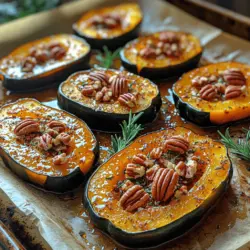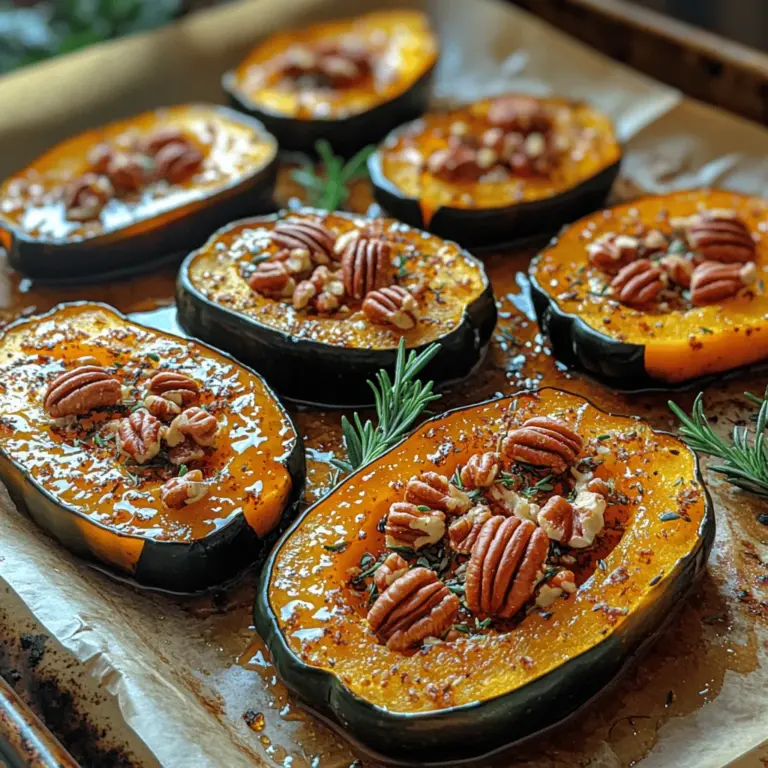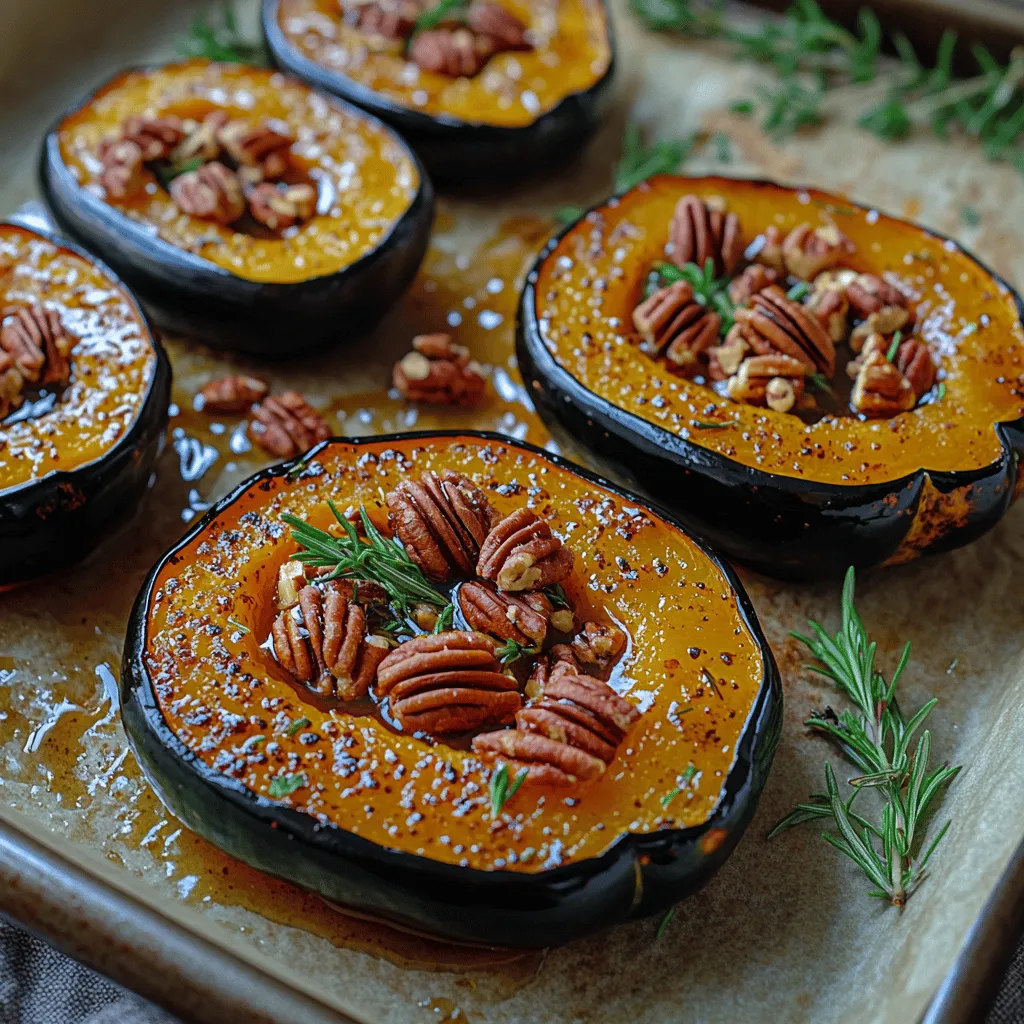Introduction
As the leaves begin to change color and the air turns crisp, one vegetable stands out as a seasonal favorite: the acorn squash. This versatile gourd, with its unique, ribbed appearance and sweet, nutty flavor, is a staple of autumn cuisine. Roasting acorn squash brings out its natural sweetness, creating a deliciously tender dish that pairs beautifully with a wide array of flavors. In this recipe for Sweet & Savory Roasted Acorn Squash with Maple Bliss, we combine the earthy taste of acorn squash with the rich sweetness of pure maple syrup, resulting in a dish that is both comforting and sophisticated.
The beauty of this recipe lies in its harmonious blend of sweet and savory elements. The caramelized edges of the roasted squash are perfectly complemented by the rich, syrupy glaze, while the addition of spices and nuts adds depth and crunch. This dish is not only a feast for the taste buds but also a visual delight, making it an excellent centerpiece for your fall dinner table. Moreover, it showcases the importance of seasonal ingredients, promoting healthy cooking methods that celebrate the bounty of autumn produce.
In this article, you can expect a comprehensive guide to preparing this delightful recipe. We’ll delve into the characteristics of acorn squash, explore the nutritional benefits of each ingredient, and provide detailed instructions to ensure your dish turns out perfectly every time. Whether you are looking for a new side dish for holiday gatherings or a unique addition to your weeknight meals, this roasted acorn squash recipe is sure to impress family and friends alike.
Understanding Acorn Squash
The acorn squash is a small to medium-sized winter squash that belongs to the Cucurbita family. Its distinctive acorn-like shape features deep ridges and a dark green skin, often mottled with shades of yellow or orange. Inside, the flesh is a vibrant orange hue, boasting a sweet and slightly nutty flavor that becomes more pronounced when roasted.
Nutritional Benefits
Acorn squash is not only delicious; it’s also packed with nutrients. This winter squash is an excellent source of vitamins A and C, both of which are essential for maintaining a healthy immune system and promoting skin health. Additionally, acorn squash provides dietary fiber, which aids in digestion and helps to maintain a feeling of fullness. It also contains important minerals like potassium and magnesium, contributing to heart health and muscle function.
Seasonal Availability
Typically, acorn squash is in season from late summer through early winter, making it a perfect ingredient for fall recipes. When selecting acorn squash at the market, look for ones that are heavy for their size, with a hard, unblemished skin. The stem should be intact, and the squash should feel firm and dense. Avoid any that have soft spots or blemishes, as these may indicate spoilage.
Culinary Uses Beyond Roasting
While roasting is a popular method of preparing acorn squash, its culinary versatility extends far beyond this technique. Acorn squash can be sliced and sautéed, pureed into soups, or even stuffed with grains, meats, and vegetables. Its subtle sweetness makes it an excellent addition to both savory and sweet dishes, including salads, casseroles, and even desserts. This adaptability makes acorn squash a valuable ingredient for home cooks looking to experiment with seasonal flavors.
Key Ingredients and Their Roles
To create the Sweet & Savory Roasted Acorn Squash with Maple Bliss, we will use a selection of simple yet impactful ingredients. Each component plays a vital role in achieving the dish’s unique flavor profile and nutritional balance.
Acorn Squash
As the star ingredient, acorn squash provides the foundation for this recipe. Its sweet and nutty flavor pairs beautifully with the other ingredients, while its tender texture enhances the overall appeal of the dish. The nutritional benefits, including vitamins, minerals, and fiber, make it a wholesome choice for any meal.
Olive Oil
Olive oil is used in this recipe to help roast the acorn squash to perfection. Its healthy fats contribute to the dish’s richness while promoting heart health. Additionally, olive oil helps to enhance the flavors of the squash and spices, making it an essential component of this recipe. When choosing olive oil, opt for extra virgin for the best flavor and health benefits.
Maple Syrup
Pure maple syrup is the secret ingredient that elevates this dish from simple roasted squash to a sweet and savory delight. Unlike imitation syrups, which are often filled with artificial flavors and high-fructose corn syrup, pure maple syrup offers a rich, complex sweetness that complements the natural flavors of the acorn squash. It also contains beneficial antioxidants and minerals like manganese and zinc.
Spices (Cinnamon and Nutmeg)
Cinnamon and nutmeg add warmth and depth to the dish, enhancing the overall flavor profile. Cinnamon is known for its anti-inflammatory properties and can help regulate blood sugar levels, while nutmeg provides a unique aromatic quality that pairs beautifully with the sweetness of the squash and maple syrup. Together, these spices create a comforting and inviting aroma that fills your kitchen as the dish roasts.
Sea Salt and Black Pepper
These essential seasonings enhance the natural flavors of the acorn squash and other ingredients. Sea salt balances the sweetness of the dish, while black pepper adds a subtle kick. Using high-quality sea salt and freshly cracked black pepper can make a significant difference in the overall taste of your roasted acorn squash.
Pecans
Pecans offer a delightful crunch and nutty flavor that contrasts beautifully with the tender squash. They are also packed with healthy fats, protein, and essential vitamins and minerals, making them a nutritious addition to this dish. Toasting the pecans before adding them enhances their flavor and adds an extra layer of richness.
Fresh Rosemary
Fresh rosemary not only adds aroma and visual appeal to the dish but also contributes a unique flavor that complements the sweetness of the maple syrup and acorn squash. This herb is rich in antioxidants and has been linked to various health benefits, including improved digestion and enhanced memory function. Using fresh rosemary instead of dried will provide a more vibrant flavor and aroma.
In the next segment, we will explore the step-by-step instructions for preparing this delicious Sweet & Savory Roasted Acorn Squash with Maple Bliss, ensuring you have all the information you need to create this seasonal dish successfully. Stay tuned for an easy-to-follow guide that will help you impress your guests or enjoy a delightful family meal.
Step-by-Step Instructions for Roasting Acorn Squash
Preheat the Oven
To begin, preheating your oven to 400°F (200°C) is essential for achieving perfectly roasted acorn squash. A consistent oven temperature ensures even cooking, which is crucial for caramelization and flavor development. The high heat will help create that beautiful golden-brown exterior while keeping the flesh tender and flavorful.
Preparing the Squash
When it comes to preparing acorn squash, the right techniques matter. Start by thoroughly washing the squash under cold running water to remove any dirt or debris. Once it’s clean, place the squash on a cutting board. Using a sharp knife, carefully slice the squash in half from stem to bottom. If you find it difficult to cut, you can microwave it for a minute or two to soften the skin slightly. After cutting, scoop out the seeds and stringy insides with a spoon. You can save the seeds for roasting later if you wish! The squash should now be ready for seasoning.
Making the Glaze
For the sweet and savory glaze, combine pure maple syrup, melted butter (or a vegan substitute), cinnamon, salt, and a pinch of nutmeg in a small bowl. Whisk until well combined. The key to a balanced glaze is to adjust the sweetness and saltiness to your liking. You may want to taste it and add more maple syrup for sweetness or salt to enhance the flavors. This glaze will add a deliciously rich taste to the squash, complementing its natural sweetness.
Glazing the Squash
Once your glaze is prepared, it’s time to coat the acorn squash. Place the squash halves cut-side up on a baking sheet lined with parchment paper. Using a pastry brush or a spoon, generously apply the glaze over the flesh of the squash, ensuring an even coating. This helps to maximize flavor infusion while the squash roasts. For an extra touch, sprinkle some brown sugar on top for added caramelization and crunch.
Roasting Process
Carefully place the baking sheet in your preheated oven and roast the squash for about 30-40 minutes. Check for doneness by piercing the flesh with a fork; it should be tender and easily pierced. The edges of the squash will start to caramelize, giving it that beautiful roasted flavor. If you desire a darker, more caramelized finish, you can turn on the broiler for the last 5 minutes, but keep a close eye to prevent burning.
Adding Pecans
Approximately 10 minutes before the squash is finished roasting, sprinkle chopped pecans over the glaze. This timing is crucial as it allows the nuts to toast slightly without becoming overly crunchy. The addition of pecans not only enhances the flavor but also adds a delightful crunch that pairs wonderfully with the creamy texture of the squash.
Finishing Touches
Once the acorn squash is beautifully roasted and the pecans are toasted, remove it from the oven and let it cool slightly. For an exquisite finish, you can drizzle a little extra maple syrup over the top and garnish with fresh herbs such as thyme or parsley for a pop of color. This not only enhances the flavor but also elevates the presentation, making it perfect for serving at gatherings.
Serving Suggestions
Ideas for Pairing Roasted Acorn Squash with Main Courses
Roasted acorn squash can serve as a versatile side dish that complements many main courses. It pairs beautifully with roasted meats such as chicken, pork, or turkey. For a fall-inspired feast, consider serving it alongside herb-roasted chicken or a savory pork tenderloin. The sweetness of the squash balances the savory flavors of the meat, creating a harmonious plate.
Serving as a Vegetarian Option
As a vegetarian dish, roasted acorn squash shines on its own. It can be served as a main course alongside grains such as quinoa or farro, making it a nutritious and filling option. The natural sweetness of the squash, combined with the crunch of the pecans, offers a delightful vegetarian meal packed with vitamins, minerals, and fiber. This dish is particularly suitable for those looking to incorporate more plant-based meals into their diet.
Presentation Tips
Presentation plays a key role in making any dish appealing. For gatherings or dinner parties, consider serving the roasted acorn squash on a rustic wooden platter or a white serving dish for contrast. To enhance visual appeal, you can add pomegranate seeds or fresh herbs around the squash. Drizzling a little extra maple syrup or balsamic reduction on the plate can also create an elegant touch that invites guests to dig in.
Nutritional Value and Dietary Considerations
Breakdown of Calories, Macronutrients, and Vitamins
Roasted acorn squash is not only delicious but also nutritious. A typical serving of roasted acorn squash (about half of a medium squash) contains approximately 115 calories. It is rich in carbohydrates, primarily coming from natural sugars, and provides around 3 grams of fiber. Additionally, acorn squash is a good source of vitamins A and C, potassium, and antioxidants, making it a healthy addition to your meals.
Suitability for Various Diets
This dish is suitable for a variety of dietary preferences, including vegan, gluten-free, and vegetarian diets. The ingredients used in the glaze can be easily modified to cater to specific dietary needs, such as using coconut oil instead of butter for a vegan option. The gluten-free nature of acorn squash makes it an excellent choice for those with gluten sensitivities, ensuring everyone can enjoy this seasonal delight.
Health Benefits of Incorporating Acorn Squash
Incorporating acorn squash into your diet offers numerous health benefits. It is low in calories while being high in fiber, which aids in digestion and helps maintain a healthy weight. The abundance of vitamins, particularly vitamin A, supports eye health and boosts the immune system. Additionally, the antioxidants found in acorn squash can help combat inflammation and reduce the risk of chronic diseases, making it a smart choice for a balanced diet.
Conclusion
The sweet and savory roasted acorn squash with maple bliss is a delightful dish that perfectly captures the essence of fall. Its combination of flavors and textures provides a satisfying experience that is both comforting and nutritious. With its versatility, you can easily serve it as a side or a main vegetarian dish, adapting it to your preferences and dietary needs.
As you experiment with this recipe, feel free to play around with different spices, such as adding a pinch of cayenne for a kick or incorporating herbs like rosemary for an earthy flavor. The possibilities are endless, and each variation can lead to a new favorite dish.
The joy of cooking with fresh, seasonal ingredients is unparalleled, and this roasted acorn squash recipe exemplifies that joy perfectly. So gather your ingredients, invite some friends over, and enjoy the warm flavors of autumn on your table.


